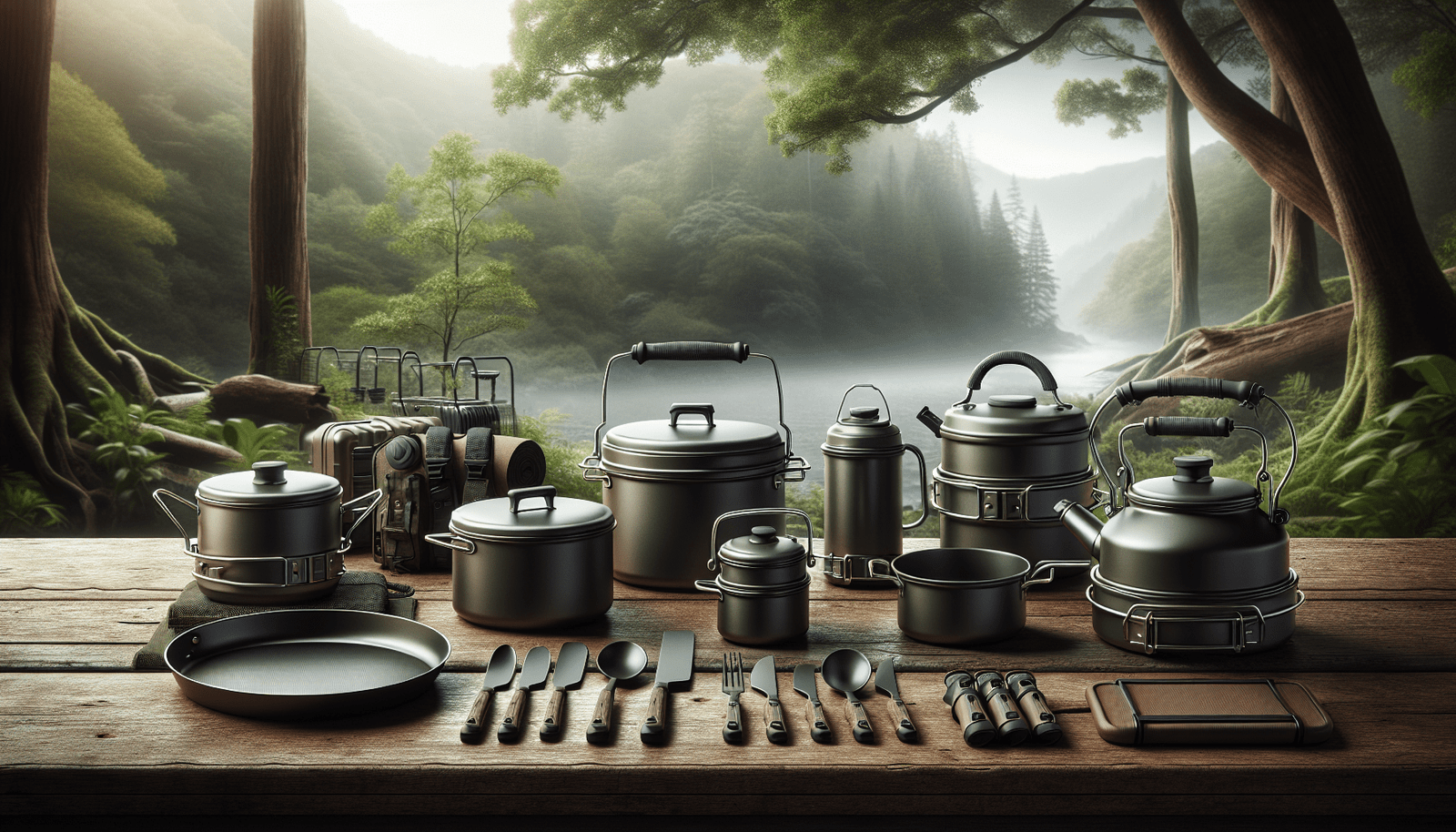When you’re getting ready for a camping trip, choosing the right cookware can make all the difference in your outdoor culinary adventures. “What To Look For In Camping Cookware?” dives into the essential features and considerations to keep in mind when selecting pots, pans, and utensils for the great outdoors. From lightweight materials that won’t weigh you down on long hikes to durable construction that can withstand the elements, this guide ensures you’re well-equipped to prepare delicious meals under the stars. Discover the key factors that will help you make the best choice, so you can enjoy your camping experience to the fullest. Have you ever found yourself overwhelmed with choices when trying to select the ideal camping cookware? With so many options on the market, it can be tricky to know what’s best for your camping needs. Whether you’re a seasoned camper or a beginner preparing for your first outdoor adventure, choosing the right cookware can make your experience more enjoyable and hassle-free.
Why is Camping Cookware Important?
Camping cookware is more than just pots and pans; it’s your gateway to delightful meals in the wild. The right tools can make a significant difference in how you cook, serve, and clean up your meals, allowing you to spend more time enjoying nature. Poor quality cookware can lead to uneven cooking, difficult clean-ups, and added frustration. Trust me, nothing ruins a beautiful camping trip quite like a burnt meal or food sticking to the pan.
Material Matters: Choosing The Right Type of Cookware
The material of your camping cookware plays a crucial role in its performance. Here are a few options to consider:
Aluminum
Pros:
- Lightweight: Great for hiking or bike trips.
- Good Heat Conductivity: Cooks food evenly and quickly.
- Affordable: Often cheaper than other materials.
Cons:
- Less Durable: Can dent and scratch easily.
- Reactive: Can react with acidic or alkaline foods.
Stainless Steel
Pros:
- Durable: Resistant to dents, scratches, and rust.
- Non-reactive: Safe to use with any food type.
- Easy to Clean: Generally dishwasher safe.
Cons:
- Weight: Heavier compared to aluminum.
- Poor Heat Conductivity: Can lead to uneven cooking unless designed with a copper or aluminum core.
Cast Iron
Pros:
- Fantastic Heat Retention: Cooks food evenly.
- Versatility: Could be used on campfire and stovetop.
- Durability: With good care, it can last for generations.
Cons:
- Very Heavy: Not ideal for backpacking or hiking trips.
- Seasoning Required: Needs to be properly seasoned and maintained to prevent rust.
Titanium
Pros:
- Ultralight: Perfect for backpackers.
- Rust-resistant: High resistance to corrosion.
- Strong and Durable: Despite being light, it’s incredibly tough.
Cons:
- Expensive: Higher cost can be a deterrent.
- Heat Distribution: Does not conduct heat as evenly, which can lead to hot spots.
Here’s a quick comparison table:
| Material | Weight | Durability | Heat Conductivity | Price |
|---|---|---|---|---|
| Aluminum | Light | Moderate | Excellent | Affordable |
| Stainless Steel | Moderate | High | Low | Moderate |
| Cast Iron | Heavy | Very High | Excellent | Moderate |
| Titanium | Ultralight | Very High | Moderate | Expensive |
Essential Pieces: What Should Be in Your Cookware Set?
When it comes to camping cookware, less is often more. You want to bring enough to cook a variety of meals, but not so much that it becomes burdensome to carry. Here are some essential pieces:
Pots and Pans
A versatile cooking pot and a frying pan can handle most meals, from boiling water to frying bacon.
Lids
Having lids can significantly speed up cooking times and help conserve fuel. Make sure they fit well and are not too heavy.
Plates and Bowls
Lightweight, durable plates and bowls are essential for serving meals. Look for those that nest together for easy packing.
Utensils
A good set of utensils is a must-have. Consider multi-functional options, like sporks, and don’t forget a spatula or a ladle if you plan on cooking more elaborate meals.
Cups and Mugs
Insulated mugs can be useful for both hot and cold beverages.
Cutting Board and Knife
A small, foldable cutting board and a sharp knife are great for meal prep.
Special Considerations
If you enjoy coffee, consider a portable coffee maker or a French press. If you’re a fan of Dutch oven cooking, bring one along for versatile, slow-cooked meals.
Packability: Making It Fit
Space is a precious commodity when camping, so your cookware should be compact and easy to pack.
Stackability
Choose items that can nest inside each other to save space. Many camping cookware sets are designed to fit together like Russian dolls.
Weight
Consider how far you’ll be carrying your gear. A heavy cast-iron skillet might be perfect for car camping but impractical for backpacking.
Handles
Look for pots and pans with folding or detachable handles to save space and prevent damage during transport.
Durability: Built to Last
Your camping cookware will be exposed to various elements, and you want it to withstand the test of time.
Material Quality
High-quality stainless steel and titanium are typically the most durable options. Aluminum is lighter but can be more susceptible to wear and tear.
Construction
Riveted handles and thick walls contribute to the longevity and robustness of your cookware.
Ease of Cleaning: No One Loves Dish Duty
Out in the wild, cleaning can become a hassle. Here are some factors to consider for easy cleanup:
Non-stick Coatings
Non-stick coatings can make cleaning much easier, but be cautious as they may scratch over time. Make sure they’re also safe and free of harmful chemicals.
Smooth Surfaces
Cookware with smooth surfaces is easier to clean than those with grooves or recesses where food can get stuck.
Dishwasher Safe
If you have access to a dishwasher post-camping trip, having dishwasher-safe options can save a lot of time and effort.
Cooking Versatility: More Than Just Boiling Water
Your cookware should be adaptable to different cooking methods, from camp stoves to open flames.
Heat Source Compatibility
Ensure the cookware you choose is compatible with your camping stove or grill. If you plan to cook over an open flame, consider cast iron for its durability.
Multi-Purpose Use
Look for items that serve more than one function, like lids that double as frying pans or pots that can be used for baking.
Cost-Effective Considerations: Getting Value for Your Money
Good camping cookware can be a worthy investment, but you shouldn’t have to break the bank.
Budget vs. Quality
Assess your budget and prioritize items that offer the best balance between cost and quality. High-end brands often provide durable, high-performance cookware, but there are also budget-friendly options that hold up well.
Full Sets vs. Individual Pieces
Sometimes, buying a complete set can be more economical than purchasing individual pieces. However, if you’re only missing one or two items, buying them separately might be the better route.
Safety First: Non-Toxic and Safe to Use
Safety should never be a secondary consideration when choosing camping cookware.
Material Safety
Opt for cookware made from food-safe materials that don’t leach chemicals into your food. Ensure that non-stick coatings are PFOA-free.
Handle Safety
Handles should be heat-resistant and firmly attached to prevent accidents. Consider removable or foldable handles for easy packing and extra safety.
Stability
Your cookware should be stable on uneven surfaces. A wider base can prevent tipping, especially when cooking on camp stoves.
Testing Your Cookware: A Trial Run
Before you head out into the wilderness, test your cookware at home.
Conduct a Test Cook
Try preparing a meal using only your camping cookware. This will help you get accustomed to its quirks and limitations.
Pack and Unpack
Practice packing and unpacking your cookware to ensure that it fits well in your backpack or car.
Clean-Up Simulation
Simulate a cleaning scenario without dish soap or running water to see how easy it is to clean on a campsite.
Eco-Friendly Choices: Being Kind to Nature
Consider the environmental impact of your cookware choices.
Sustainable Materials
Opt for materials like stainless steel and aluminum, which are recyclable. Avoid disposable options whenever possible.
Long-Life Products
Investing in durable, high-quality items reduces the need for replacements, minimizing waste.
Packaging and Brands
Choose brands that prioritize eco-friendly packaging and sustainable practices in their manufacturing processes.
Personal Requirements: Customizing Your Cookware
Finally, tailor your cookware to meet your specific needs.
Group Size
A family camping trip will require more extensive cookware compared to a solo adventure. Assess the size and number of pots and pans needed.
Type of Meals
If you enjoy gourmet outdoor cooking, invest in specialized equipment like a griddle or a Dutch oven. For simple meals, a basic cookware set will suffice.
Frequency of Use
For frequent campers, investing in high-quality, durable cookware might be more cost-effective in the long run than continually replacing cheaper options.
Conclusion
Choosing the right camping cookware involves considering various factors like material, durability, weight, and cooking versatility. It’s about finding that sweet spot where convenience meets functionality, allowing you to enjoy your meals and make the most out of your outdoor adventures. So, go ahead, embark on your quest for the perfect camping cookware, and may your meals in the wild be as delightful as the landscape around you. Happy camping!

